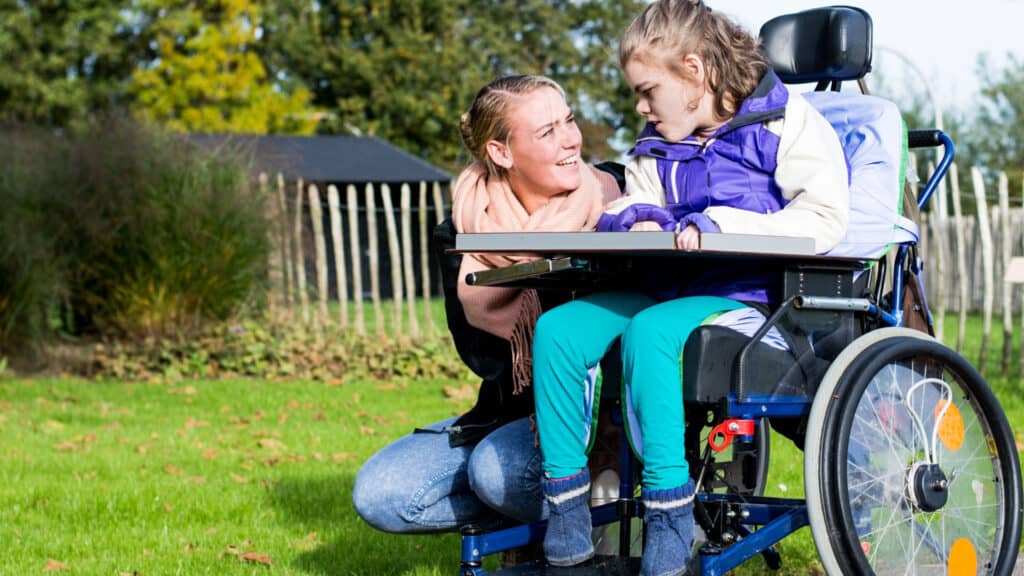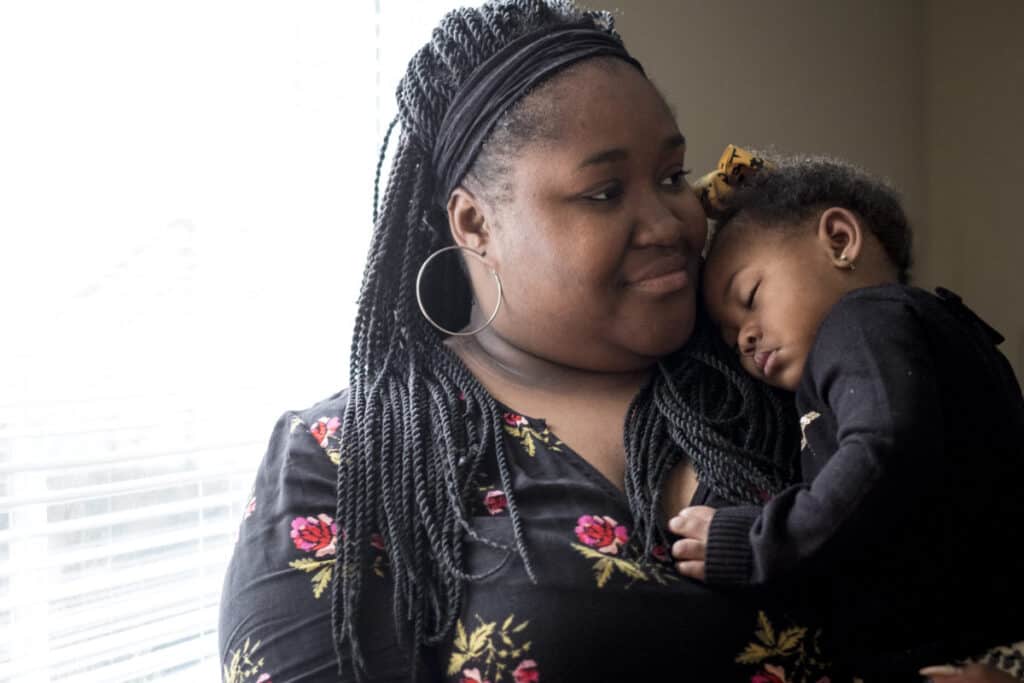There is a huge range of ways that disabilities can affect our kids. Some of our kids may have a learning disability and need a little extra help in school. Others may do ok in school, but have sensory or social issues that affect their comfort level and how they interact in certain environments. Most of the resources out there seem to focus on these types of disabilities. But if you have a child with a severe disability–especially if it’s an intellectual disability (ID), you need different guidance – which can be harder to find.
A child with a severe physical disability does not necessarily have an ID (intellectual disability). This article is for families and caregivers of children with an ID, who require a very different learning process than a typical student. As your child with an ID gets older, their schooling may look very different from their peers’ schooling, and much of the general information you read may not apply.
If you have a young child, read on to learn some basics about supporting a child with significant intellectual disabilities. If your child is in their teens, read about how to prepare for their future after school.
First, know that you’re not alone! There are a lot of people and programs that can help. It’s a hard journey caring for a child with lots of needs, but you are here to learn what to do. That’s a great step.
Here are some important things you should know about finding support for your child and planning for their future.
Important terms to know
Intellectual Disability (ID) and Cognitive Disability mean the same thing. “Intellectual” or “cognitive” refers to how someone’s mind works. This kind of disability means that a person has limited mental capacity. They may have trouble thinking, learning, communicating, or taking care of their own daily needs. This kind of disability can be mild or severe.
I/DD, or Intellectual and Developmental Disability is the term used when a person has an intellectual disability and also one or more developmental disabilities, which can include sensory, physical, or emotional differences.
ADLs, or Activities of Daily Living, are self-care tasks that a person needs to do every day. These include dressing, eating, bathing, and toileting (using the bathroom). When they talk about ADLs for children, they mean the tasks that most kids their age can do for themselves.
Adaptive Behaviors are the things that people typically do in daily life, at their current age level. They include ADLs and other things like following rules in school, making friends, or living independently. Adaptive behaviors also include social and communication skills and allow people to access their school and community.
Alternate Assessment is the alternate form of the state assessment, for students with significant intellectual disabilities. It does not cover the same academic material as the regular assessments, but documents what the student is learning based on their IEP goals.
What to believe: facts about children with severe disabilities
People with an intellectual disability (ID) can learn new skills.
Don’t let anyone tell you that your child can’t learn. They just need very specialized and focused teaching, and their steps to improvement may be smaller and take a little more time. They may not learn the same skills as typical children, but they can make progress toward their own goals.
Not all kids who are autistic or developmentally disabled have an ID.
Sometimes people assume that if a child doesn’t speak (or speak in a typical way) then they can’t think clearly and learn complex skills. This is not necessarily true. There can be a lot going on in a child’s head, but their caregivers haven’t figured out yet how to help them access and communicate this knowledge. A speech therapist can help many children learn to communicate in a way that works for them. For example, they may teach a child to use visual symbols, or a higher tech AAC device (AAC: Augmentative and Alternative Communication).
You are not alone!
There are services and programs to support children with intellectual disabilities and their families. First, know that your child can stay in school and keep getting the services in their IEP until they turn 22.
Specialized learning and assessment in school
If your child is not able to follow your state’s standard requirements for learning in each grade, they will have specialized teaching and will take an alternate form of your state’s assessment. They may be in a specialized classroom where they can get more personal attention from trained special education teachers. Most states also have special education schools that serve only children with disabilities.
Least Restrictive Environment (LRE): The IDEA law requires that students with disabilities must be taught with their non-disabled peers as much as possible. Most parents agree that this is good for their child. The LRE is the closest they can get to being in a typical classroom all day, and the school must offer support to help make this work. Even if your child needs instruction in a separate classroom, they should be able to join the other students at lunch, recess, or after-school events as much as possible. They may also be able to take some elective classes with their peers.
But many students with ID do need to be in a different environment so they have more intense support. They may need help learning basic self-care skills like dressing, toileting, and eating, even when they get older. Or maybe they are working with a speech therapist to learn how to use a communication device.
The school is required to teach your child–no matter how great their needs are–until they turn 22 (unless they get a high school diploma sooner.) The law guarantees them an education, including therapies like speech, occupational, and behavioral if needed. It’s illegal for a school district to refuse to educate a child. They are required to find special educators and address your child’s needs.
If you feel that your child’s school is not meeting their needs, call your local Parent Training and Information Center (PTIC). They can advise you on your rights and how to get your child the right services.
************************
Louisiana:
Use the Louisiana Disability Services Finder (en español) to find specialized schools and learning programs for kids with disabilities.
If your child is developmentally disabled, deaf, or visually impaired, they may be able to qualify for one of the Special Program schools in Louisiana. See the Special School District web page or call 225-757-3370.
Learn about Louisiana’s Alternate Assessment: LEAP Connect.
Massachusetts:
Use the Massachusetts Disability Service Finder (en español)to find specialized schools for kids with disabilities. They are called 766 schools. Your home district will need to agree during the IEP process to refer your child to a 766 school.
************************
Benefits, services, and in-home help
There are many services available through the federal and state government to help care for children and adults with significant disabilities. Here are some examples:
- SSI: Supplemental Security Income: Monthly cash payments to help support daily needs for people with low income or disabilities. Children with disabilities can sometimes qualify, even if the family doesn’t
- State Agencies for I/DD or Disability Services: Each state has a department to support residents with I/DD. They offer a variety of services and can lead you to other local resources
- Medicaid: Public health insurance for people with low income or disabilities. Medicaid usually has good benefits for people with disabilities and can pay for things like Personal Care Attendants (PCAs), different kinds of therapies, and even diapers or pull-ups for older kids and adults. Children with disabilities may qualify, even if the family is above the income limit
- Flexible Family Spending: Extra money for specific needs related to a person’s disability. This is usually through your state’s agency for disability support
- Personal Care Attendant (PCA) or Direct Service Worker (DSW): A trained person who is hired to help people with their ADLs and other daily tasks. State disability programs, Medicaid, and other insurance can often pay for these services
- Respite care: Hired caregivers who are trained to stay with people with significant disabilities to give the parent or main caregiver a break. They can watch your child or family member for a few hours or a few days, depending on the program. Insurance or state service agencies can often provide free respite care options
Taking care of yourself
Caring for a child (or adult) who needs a lot of support can be a rich and fulfilling experience. But it can also be challenging and stressful. Caregivers and parents sometimes forget to take care of themselves as much as they take care of their children.
When your child is very different from others their age, it can also be isolating and emotionally draining. It’s not easy to see so many other families with kids who can do things that yours can’t. So you may need to work harder to make connections and be open and proud about who your child is.
Here are some tips to take care of YOU:
- Take a break when you need it. Don’t try to do everything possible all at once. It’s ok to sit down, have some tea, and put your feet up! Look into respite care to give you a bit of time off
- Reach out to others when you need help. Don’t drift away from your friends and community. They are usually eager and happy to help.
- Look for counseling services if you need them. Some of your child’s service programs may include counseling and support for parents. Ask about it
- Connect with support organizations and other parents of children with similar disabilities. You can get useful advice and tips. But more importantly you will know that you’re not alone – and not crazy for feeling however you feel at any moment. There is a lot of compassion and understanding floating around. Building a community of support around your child and your family can really help. Tap into it!
Vision of the Future
If your child has an Intellectual Disability (ID), they will probably need more care as adults. This could mean a little support managing a household and a job, or it could be round-the-clock care.
Think carefully about what your child’s life might look like after they turn 22 [h3]
- Will they live with you or in a supported living situation?
- Could they work or volunteer if they had support?
- What are some ways they can engage with the community? What do they like to do?
- What makes them happy?
Transition planning should be based on your vision for their future
Make sure that your child’s IEP and transition plan address the skills they’ll need for that future. They may need to learn things like self-care (ADLs), social skills, communication, and safety.
When your child is 14 or older, talk with the IEP team about connecting with social service agencies for adults with disabilities. You must give the school permission to do this, and it will be very useful. These agencies can help your child in many ways during the transition and after they leave school.
Social service programs for adults with disabilities
These include the benefits and services listed above but there are also programs for adults, and for teens who are transitioning to adult life. If your child is over 16, their transition planning in school should include connecting with these organizations.
Adult services include Vocational Rehabilitation (VR) programs that offer employment training and on-the-job support. VR programs can often help adults with I/DD to find and manage jobs at their skill level.
Decision-making
When children turn 18, they are legal adults and can make their own decisions. Parents can no longer sign papers like IEPs or consent forms for medical care. Many people with I/DD will need lots of support making these decisions, and some will need a legal guardian to make all or some decisions for them.
Learn more about what to do when your child turns 18.
It may seem like a lot to envision your child’s best future, set up the services to prepare for it, and take care of yourself in the meantime. Caring for a child with severe disabilities may require more support, but once you set it up, you can spend more of your energy loving and enjoying them!



